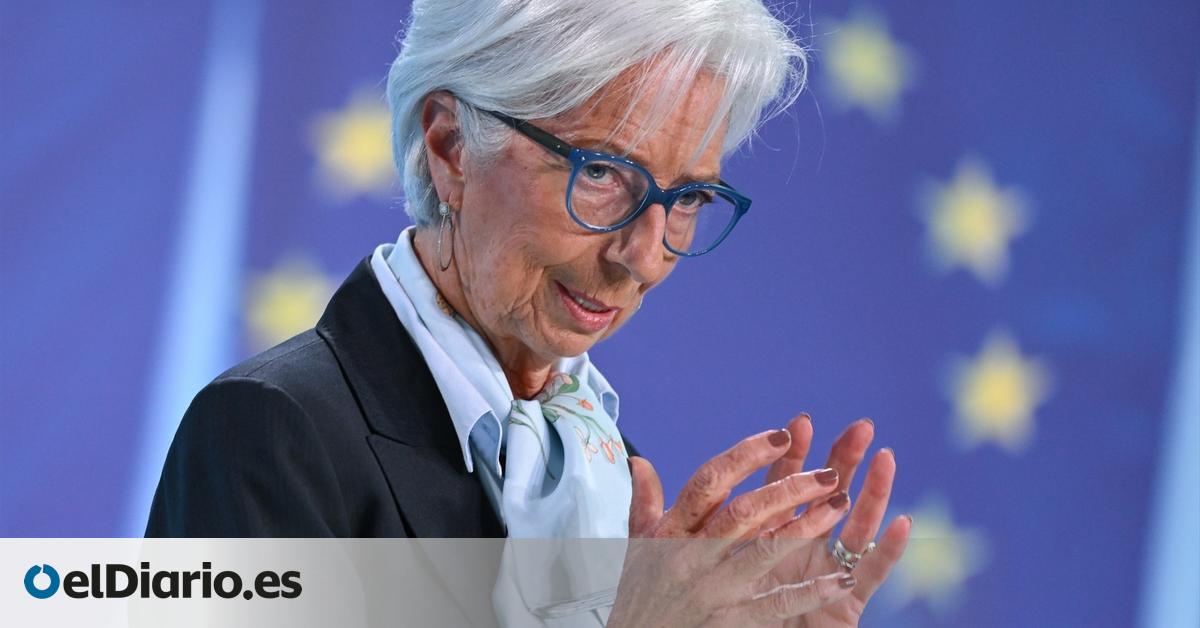
The European Central Bank (ECB) has cut official interest rates by 0.25 points, from 4.5% to 4.25%, as expected. With this decision, the institution chaired by Christine Lagarde breathes oxygen into the growth of the eurozone economy, where weakness reigns (especially in Germany), with the notable exception of Spain for the record creation of jobs (and more quality) and by the strength of tourism and the rest of the foreign sector.
The ECB thus begins to reverse the monetary austerity that has suffocated mortgaged families in recent months and that has damaged consumption in general and business investment and activity as a whole. What is not clear is what the institution’s governing council will do at its next regular meetings in July and September, and whether this first drop in the official ‘price’ of money will remain only a symbolic act. “We will base ourselves on the data and decide meeting by meeting,” says the ECB in its statement this Thursday.
In the update of the forecasts of the institution’s economists, general inflation has been revised slightly upwards for 2024 and 2025 compared to the March projections, although they suggest that it will remain normalized in the coming months. Economists now project that it will average 2.5% in 2024, 2.2% in 2025 and 1.9% in 2026. According to the same estimates, “economic growth (of GDP) will be 0.9% in 2024, 1.4% in 2025 and 1.6% in 2026”, always for the eurozone as a whole.
In July 2022, the ECB began the classic strategy of fighting against monetary policy price increases, raising the reference interest rates – with respect to those set, for example, by the Euribor, which in recent weeks has advanced the cut this Thursday (in the graph)—, from 0% to 4.5% where it left them in the fall of 2023.
“Based on an updated assessment of the inflation outlook, underlying inflation dynamics and the strength of monetary policy transmission, it is now appropriate to moderate the degree of monetary policy tightening after nine months of maintaining stable rates,” begins the ECB statement this Thursday.
Monetary austerity, shared with all the central banks of Western countries, has sought to suffocate families and companies by making mortgages and other loans more expensive to hit demand and, therefore, moderate inflation, as a consequence. A “flamethrower” policy with which the ECB has indeed done damage, but with which it has barely participated in the normalization of price increases – the main mandate of the institution.
The increases in interest rates have assumed the risk of pushing eurozone economies into recession and, at the same time, have ignored that the inflation they were trying to quell was more related to issues of supply than demand: bottlenecks in world trade in the exit from health restrictions due to the pandemic, the energy crisis that was generated for the same reason and that exacerbated the Russian invasion of Ukraine…
Thus, inflation began to moderate throughout the eurozone and especially in Spain, from mid-2022 and in 2023, with the cheaper electricity, gas and fuel, before the ECB will take interest rates to maximums not seen since 2008. In fact, the March 2024 estimates of the institution’s economists were already confident that price increases will remain close to the theoretical objective of 2% towards the end of 2024, on average in the eurozone .
“Since the meeting of the Governing Council in September 2023, inflation has fallen by more than 2.5 percentage points and the inflation outlook has improved notably,” the ECB statement states. “Despite gains in recent quarters, domestic price pressures remain strong as wage growth is elevated and inflation is likely to remain above target well into next year,” qualifies.
Those who continue to defend the policy of “killing flies with cannon shots” of the ECB and the rest of the central banks of developed countries cling, on the one hand, to the fact that “real inflation depends on previous expectations,” as explained by Eric Dor, director of Economic Studies at the IÉSEG School of Management. That is to say, the aggressiveness of the monetary institution serves to set expectations, as a warning.
“The argument is that if managers reduce their forecasts for future inflation, companies will be less likely to want to protect themselves against fear of future cost increases by immediately raising prices. Likewise, if employees reduce their projections of future inflation, their demands for wage increases, which would then be reflected in higher prices, are lower. However, reality shows that it is the projections of future inflation that follow real inflation, and not the other way around,” details Eric Dor.
Dependence on the United States Federal Reserve
On the other hand, the same positions refer to the dependence on the Federal Reserve (Fed) of the United States, which marked the path of interest rate increases (it started months earlier than in the eurozone) and has gone further. And why does what the Fed does influence the decisions of the ECB? Because there is a risk of a sudden depreciation of the euro against the dollar if the paths of one central bank and another diverge greatly. And a fall in the ‘common currency’ with respect to the North American currency automatically makes imports of oil, gas and most raw materials, which are normally traded in dollars in international markets, more expensive. That is, the risk of a depreciation of the euro is an inflationary threat in Spain, Germany, France, Italy…
“The ECB’s decision to raise rates after the Fed and cut them before indicates different inflation dynamics on each side of the Atlantic. Eurozone inflation is largely attributed to a shortage of supply rather than excess demand. That said, it seems unlikely that the ECB will implement more than two rate cuts alone, before the Federal Reserve does so this year,” observes Sylvain Broyer, chief European economist at S&P Global.
Those that have noticed a direct effect of the ECB’s monetary policy decisions have been the banks, which have not stopped increasing and increasing their profits. But the arguments that have been creeping into the governing council of the eurozone institution to resist guaranteeing a significant relief in interest rates in the coming months, after the first cut this Thursday, is the risk that the Salaries continue to increase…
In the ECB’s analysis, the inflation generated by large companies when transferring increases in energy costs to sales prices to defend or widen their profit margins barely counts. Nor the damage that ‘expensive’ financing entails for family consumption, for activity, in general, and for productive investment, specifically, despite the fact that it is currently crucial to continue the fight against climate change, against inequality and advance the digital transition.
Source: www.eldiario.es

